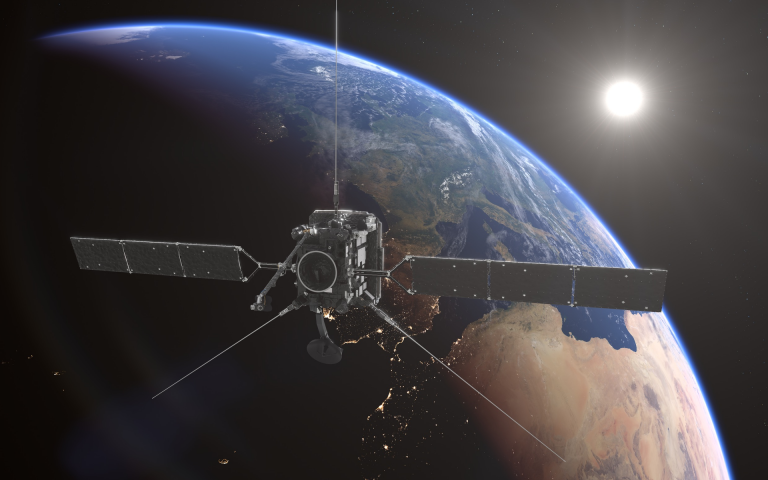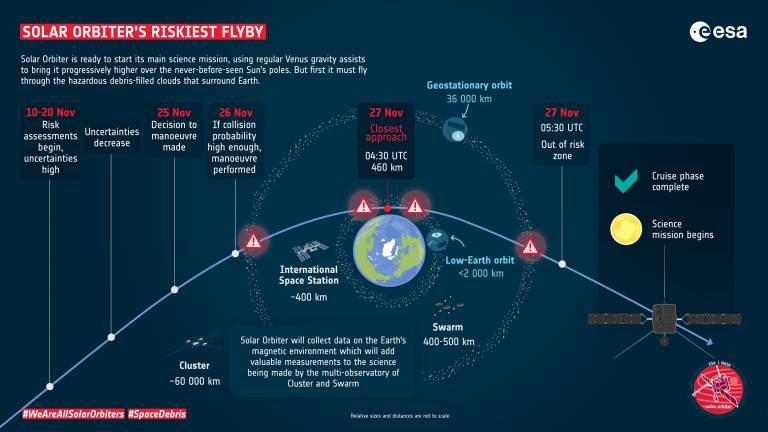Solar Orbiter returns to Earth ahead of main science mission
19 November 2021
Solar Orbiter, a European Space Agency (ESA) spacecraft carrying instruments proposed, designed and built at UCL, is returning to Earth for a flyby passing through clouds of space debris before starting its main science mission exploring the Sun.

The Earth flyby, the riskiest ever undertaken by a space science mission because of the risk of collision, takes place a week on Saturday, on 27 November. At 04:30 GMT (05:30 CET) on that day, the spacecraft will be at its closest approach, just 460 km above North Africa and the Canary Islands. This is almost as close as the orbit of the International Space Station.
The manoeuvre is essential to decrease the energy of the spacecraft and line it up for its next close pass of the Sun but it comes with a risk.
Professor Lucie Green (UCL Mullard Space Science Laboratory) said: “Space debris is of increasing concern and the number of near misses, although rare, is on the rise. The recent Russian satellite that was purposely destroyed into thousands of pieces shows how the problem is worsening.
“Solar Orbiter passing close by the Earth should be occasion to celebrate. We should be looking up and waving, marking this milestone in its journey. But instead we are crossing our fingers and hoping for its safe passage.”
The spacecraft must pass through two orbital regions, each of which is populated with space debris.
The first is the geostationary ring of satellites at 36 000 km, and the second is the collection of low Earth orbits at around 400 km. As a result, there is a small risk of a collision. Solar Orbiter’s operations team are monitoring the situation very closely and will alter the spacecraft’s trajectory if it appears to be in any danger.
Start of main science phase
Solar Orbiter will make its closest pass to the Sun in March. Its first pass, called a perihelion, took place in June 2020, with the spacecraft closing to 77 million kilometres. This time, Solar Orbiter will draw to within 50 million kilometres, a third of the distance between the Sun and Earth – providing a significant boost to the science that can be done.
UCL scientists have a leading role in two of the spacecraft’s instruments – the Extreme Ultraviolet Imager (EUI), a suite of telescopes providing images of the hot and cold layers of the Sun’s atmosphere and corona, and the Solar Wind Analyser (SWA).
Professor Chris Owen (UCL Mullard Space Science Laboratory), Principal Investigator on the SWA instrument, said: “The Earth flyby represents the transition of Solar Orbiter’s mission from ‘cruise phase’ into ‘nominal mission phase’ operations.
“For this new phase, the Deep Space Network tracking of the spacecraft and download of recorded data increases to daily, but more importantly we have the opportunity to begin observing campaigns in which the entire payload, made up of 10 distinct instruments, will begin to be operated in coordination.
“The first set of campaigns, including one coordinated by members of the EUI and SWA teams at MSSL, will be run during the next perihelion pass in March. I am certainly looking forward to these early opportunities to address the big science goals of Solar Orbiter.”

The next close pass of the Sun will bring new views of the enigmatic ‘campfires’ that Solar Orbiter saw at the first perihelion. The campfires could hold clues about how the Sun’s outer atmosphere has a temperature of millions of degrees, while the surface has a temperature of thousands – which seemingly defies physics because heat should not be able to flow from a colder to a hotter object.
And while Solar Orbiter is not going as close to the Sun as NASA’s Parker Solar Probe, this is by design because it allows Solar Orbiter to not only measure what is happening in the solar wind, but to also carry telescopes that can look at the Sun without being destroyed by the heat. The two data sets can then be compared to link activity on the Sun’s surface to the space weather around the spacecraft.
But before any of this takes place, Solar Orbiter must complete its flyby of Earth. And this presents an opportunity for eagle-eyed sky watchers to bid a final farewell to the spacecraft before it heads forever into deep space.
In the moments leading up to closest approach, skywatchers in the Canaries and North Africa could catch a brief glimpse of the spacecraft speeding through the sky. It will be travelling at about 0.3 degrees per second, which is just over half the apparent diameter of the Moon every second. For most observers it will be too faint to spot with the unaided eye, and too fast for telescopes to track, so binoculars should provide the best chance of catching a glimpse.
When Solar Orbiter re-emerges from the Earth’s shadow it will be on course for its rendezvous with the Sun and the never-before-seen solar polar regions.
Earth science opportunity
The flyby also offers a unique opportunity to study the Earth’s magnetic field. This is a subject of intense interest because the magnetic field is our atmosphere’s interface with the solar wind, the constant ‘wind’ of particles given off by the Sun. Not only can particles from the solar wind penetrate the magnetic field and spark the aurora in our skies, but atoms from our atmosphere can also be lost into space.
The details of these interactions are being studied by two ESA missions: Cluster’s four satellites, which include instruments designed and built at UCL, which are at 60 000 km in altitude, and Swarm’s three spacecraft at 400 km. Multiple spacecraft are needed to break the so-called space-time ambiguity. This is the name given to the uncertainty over whether a change has taken place because a spacecraft has flown into a different region with different conditions (a change in space) or is flying through a region that changes its conditions (a change in time).
Solar Orbiter’s flyby offers a unique opportunity to take even more data. It will sweep into the Earth’s magnetic field from out beyond Clusters orbit, approach Swarm’s orbit at closest approach and then fly back out again. This will provide even more data points from which to reconstruct the condition and behaviour of Earth’s magnetic field during the flyby.
Links
- ESA Solar Orbiter
- ESA news story
- Professor Chris Owen’s academic profile
- Dr David Long’s academic profile
- Professor Lucie Green’s academic profile
- UCL Mullard Space Science Laboratory
- UCL Mathematical & Physical Sciences
Images
- Top: an artist's impression of Solar Orbiter making a flyby at Earth. Solar Orbiter will make one gravity assist flyby of Earth and numerous flybys of Venus over the course of its mission to adjust its orbit, bringing it closer to the Sun and also out of the plane of the Solar System to observe the Sun from progressively higher inclinations. This will result in the spacecraft being able to take the first ever images of the Sun’s polar regions, crucial for understanding how the Sun ‘works’. Credit: ESA
- Middle: Solar Orbiter’s crucial flyby of Earth on 27 November will place the spacecraft onto the correct orbit for its science phase to begin. But the manoeuvre is not without risk. At closest approach, the spacecraft will be around 460 km above our planet. This is in the Low Earth Orbit zone, where the International Space Station and many other spacecraft can be found. It is also home to a lot of space debris, meaning that there is a small risk of a collision between Solar Orbiter and some space junk. Credit: ESA
Media contact
Mark Greaves
T: +44 (0)7990 675947
E: m.greaves [at] ucl.ac.uk
 Close
Close

